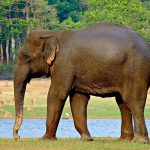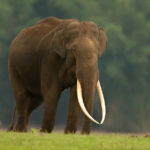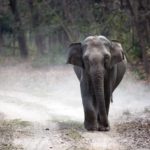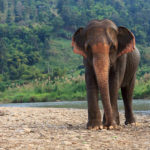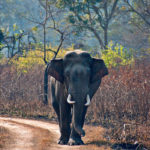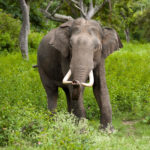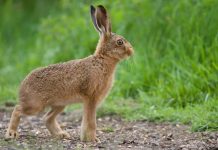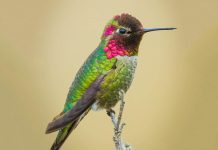The Indian Elephant is a native species to mainland Asia. The scientific name for Indian elephants is Elephas maximus indicus. They are recognized to be the subspecies of Asian Elephants. In the IUCN Red List, Indian elephants are listed as endangered because their population is declining at a very fast pace. The main reason for this is degradation, fragmentation and loss of habitat.
The Indian elephant is regarded as one of the largest living land mammals on Earth. These elephants have been given great significance in Asian culture. Since ancient time, Indian elephants have been used for moving heavy objects, for transportation, as well as they had been owned as pets by many people.
Physical Appearance
The size of an adult Indian Elephant can be 6.6 feet to 11.5 feet. Their weight can be around 2000 kilograms to 5000 kilograms. They have a very large body and large head with short neck. They have thick and medium sized legs but their legs are strong enough to behold their heavy body.
Indian elephants have well shaped large ears and trunk that make them look even more gigantic. They do most of their activities with the help of their trunk. Indian elephants mostly possess brown to grey skin color.
Behavior
Indian elephants are typically found in family groups called herds, led by the largest and oldest member. Herds usually consist of 8 to 90 elephants. Indian elephants are entirely herbivorous, spending most of their time grazing on grasses. These elephants mostly prefer to live near fresh water so that they can drink water after eating and whenever required. Elephants prefer to bath in lakes or other water sources near to them whenever they feel hot in summers. They take water in their trunks and pour it on their body to clean themselves.
Facts About Indian Elephants
- Indian elephants can eat food and feed themselves for around 19 hours in a day and they produce around 220 pounds of the dung each day.
- Indian elephants follow a definite migration route to migrate each and every year along with herd.
- Indian elephants can drink around 53 gallons of water in a single day during summer season.
- Trunk of an Indian elephant consists of 150000 muscles and without any bone.
- Indian elephants are mostly classified as mega fauna because of their heavy and large body.
Indian Elephant Diet
Indian elephants are mega-herbivorous animals as they rely completely on vegetation for their diet. They can easily consume around 150 kilograms of grasses and plant material in a day. Indian elephants feed on grasses as well as on shrubs and trees so they are considered to be both browsers and grazers.
Because of their heavy diet, these elephants clear large areas and fields of vegetation which eventually gives space to new vegetation to grow. When these elephants live near the cultivated areas, they prefer to eat crops like sugarcane, rice or banana. They eat a lot but they need water to drink only once a day.
Habitat
Indian elephants are found in most parts of Asia mainly in India, Nepal, Bhutan, Bangladesh, Myanmar, Malay Peninsula, Thailand, China, Vietnam, Cambodia, Laos and Pakistan. These elephants are generalist species which means they can live in different kinds of habitats including grasslands, tropical and evergreen forests, dry deciduous forests, moist deciduous forests, cultivated fields, dry thorn forests and secondary forests.
Indian elephants mostly prefer to inhabit such areas because they only eat vegetation and they find a good amount of vegetation in these habitats. Also it is easy for them to find fresh water in moist forests.
Domestication
Humans have used elephants for various purposes, such as transportation, logging, work in camps, as war animals to fight enemies, and for other tasks. Nowadays in Asia especially in India, elephants are also being used by tourist industry. In some tourist destinations in India you can find that travelers sit on elephants to roam across beautiful places so that they can cover large areas and enjoy scenic views being sitting on elephant. It is mostly used for wildlife safari. Kids also enjoy elephant rides.
Some people also keep elephants as pet but it is not a good option because elephants eat too much and they defecate many times a day and in a large quantity. Also it is hard for anyone to control elephants because of their heavy size. However Indian elephants are mostly kept as a livestock in highly fortified enclosures.
Reproduction
Female elephants begin to breed when they reach age of around 10 to 15 years. After the gestation period of around 22 months, female elephants give birth to one baby elephant which is called calf. Elephant calf usually weighs around 100 kilograms.
Till 5 years of age, elephant calves stay close to their mother and they are taken properly cared by their mother and other females of their respective herd. After 5 years of age, male calves mostly leave the herd and live separately whereas female calves stay with their herd only.
Taking Care Of Indian Elephants
If you want to keep Indian elephant in captivity or as livestock, you have to take very good care of them especially of their diet. You have to give them bananas, green grasses and leaves in a good quantity which is perfectly suitable for their diet. Over eating may cause over weight problem in elephants, so you should watch over that. Also elephants need open and large area to roam and walk, so make sure you give them enough space for that. In the wild, elephants naturally roam for tens of miles or more to gather food, making it an integral part of their behavior.
Health issues that are frequent and very common with Indian elephants are ulcers, cracked toes and some other foot problems. You have to take proper care of your elephant if it is seem to be affected by any health issue.
Images, Pics, Photos and Pictures Of Indian Elephant
Threats
The population of Indian elephant is highly vulnerable to wicked poachers because of their immensely precious and unique ivory tusks. Only male Indian elephants are gifted with ivory tusks and not the female ones. There is ban on the trade of the ivory but still many people do this illegal task and because of this they hunt elephants in large numbers.
Another reason for decline in the population of Indian elephant is their habitat loss. Humans are cutting down forests and vegetation to develop the societies. Humans need land to live, so they have destroyed the habitats of elephants because of which large number of Indian elephants migrate to a new place while some die due to starvation and loss of habitat. Elephants, in search of vegetation and habitat, sometimes enter green fields and farms grown by humans and destroy them. This leads to the conflict between humans and animals.
In order to conserve population of Indian elephants, an initiative called Elephant Conservation Project was started. Many national parks and wildlife sanctuaries were established in Asia for conservation of Indian elephants. All these efforts tend to save Indian elephants from extinction.

